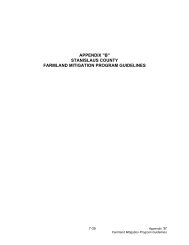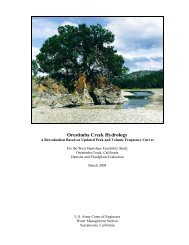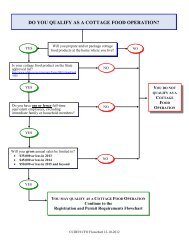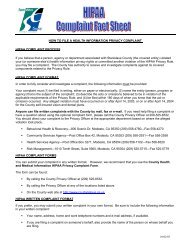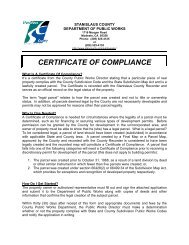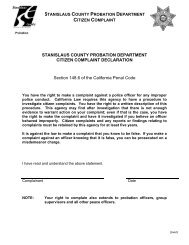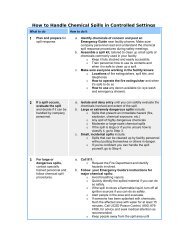Orestimba Creek Feasibility Study - Stanislaus County
Orestimba Creek Feasibility Study - Stanislaus County
Orestimba Creek Feasibility Study - Stanislaus County
You also want an ePaper? Increase the reach of your titles
YUMPU automatically turns print PDFs into web optimized ePapers that Google loves.
Economics Appendix – Draft Report - <strong>Orestimba</strong> <strong>Creek</strong> <strong>Feasibility</strong> <strong>Study</strong>, <strong>Stanislaus</strong> <strong>County</strong>, California – September 2012<br />
Attachment C: Regional Economic Development (RED)<br />
Regional Economic Impact of Funding Flood Risk Management Construction<br />
<strong>Orestimba</strong> <strong>Creek</strong> Project<br />
The US Army Corps of Engineers (USACE) planning guidance notebook (ER 1105-2-100) states<br />
that while National Economic Development (NED) and Environmental Quality (EQ) accounts<br />
are required, display of Regional Economic Development (RED) is discretionary. The Corps<br />
1991 NED Procedures Manual states there should be no doubt that RED benefits are real and<br />
legitimate benefits. The concern, from a federal perspective, is that they are often offset by RED<br />
activity in other regions. But for the local community, these benefits are important and can help<br />
them in making their preferred planning decisions.<br />
Existing guidance from USACE offers limited detail in describing either the definition or the<br />
procedures to determine RED 11 . Principles and Guidelines (P&G 1983) states that the RED<br />
account registers changes in the distribution of regional economic activity that result from each<br />
alternative plan. Evaluations of regional effects are to be carried out using nationally consistent<br />
projections of income, employment, output and population.<br />
Input-output models are characterized by their ability to evaluate the effects of industries on each other,<br />
through both the assumptions that any industry uses the outputs of others as its inputs, and that the outputs<br />
of any industry are partly used by other industries. Most typical measures of economic activity examine<br />
only the total output or employment of an industry, or the amount of final consumption demand provided<br />
by a given industry. The input-output model provides a much more comprehensive view of the interrelated<br />
economic impacts.<br />
Specifically, levee and floodwall construction projects as well as procurement activities directly create<br />
employment and purchases of goods and services throughout the <strong>County</strong> of <strong>Stanislaus</strong> and the State of<br />
California; however, economic activities associated with flood related construction funds do not end with<br />
construction and procurement. These activities also create jobs and output in other industries in the State<br />
and <strong>County</strong>.<br />
The econometric analysis allows for the evaluations of the full range of economic impacts related to<br />
specific economic activities (construction and procurement) by calculating the direct, indirect, and<br />
induced benefits of the activities in the specific geographical designation (<strong>Stanislaus</strong> <strong>County</strong> and State of<br />
California).<br />
* Direct Benefits consist of economic activity contained exclusively within the designated<br />
sector(s). This includes all expenditures made by the companies or organizations in the industry<br />
and all employees who work directly for them.<br />
* Indirect Benefits define the creation of additional economic activity that results from linked<br />
businesses, suppliers of goods and services, and provision of operating inputs.<br />
* Induced Benefits measure the consumption expenditures of direct and indirect sector<br />
11 The Institute of Water Resources released a draft White Paper titled Review or Guidance and Procedures of<br />
Regional Economic Development and Other Social Effects, August 2006. The analysis of RED for this study is<br />
consistent with this draft document.<br />
77






